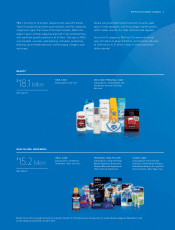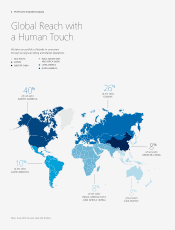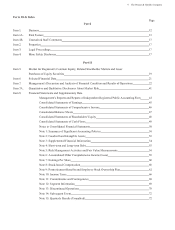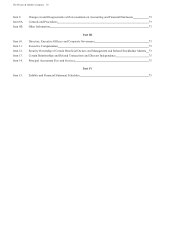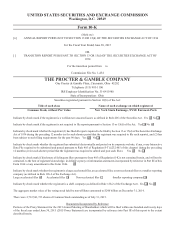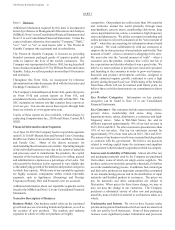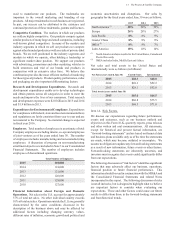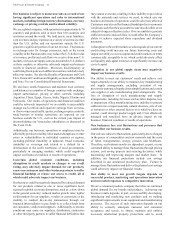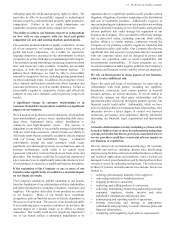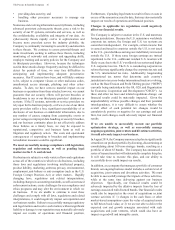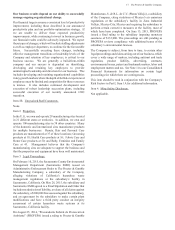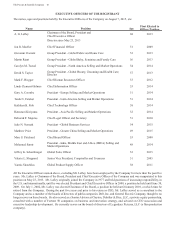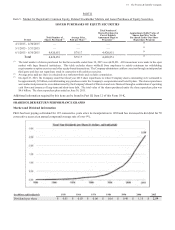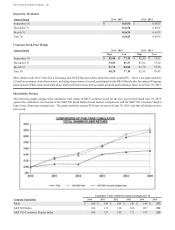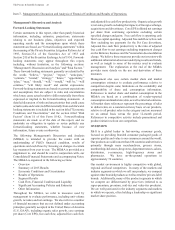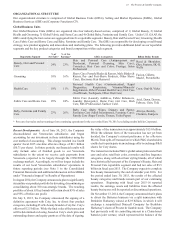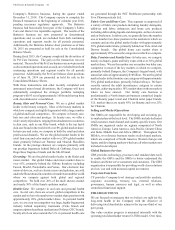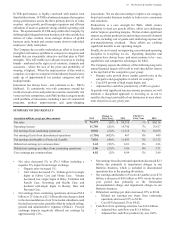Proctor and Gamble 2015 Annual Report Download - page 18
Download and view the complete annual report
Please find page 18 of the 2015 Proctor and Gamble annual report below. You can navigate through the pages in the report by either clicking on the pages listed below, or by using the keyword search tool below to find specific information within the annual report.The Procter & Gamble Company 16
providing data security and
handling other processes necessary to manage our
business.
Numerous and evolving information security threats, including
advanced persistent cybersecurity threats, pose a risk to the
security of our IT systems, networks and services, as well as
the confidentiality, availability and integrity of our data. As
cybersecurity threats rapidly evolve in sophistication and
become more prevalent across the industry globally, the
Company is continually increasing its sensitivity and attention
to these threats. e continue to assess potential threats and
make investments seeking to address these threats, including
monitoring of networks and systems and upgrading skills,
employee training and security policies for the Company and
its third-party providers. However, because the techniques
used in these attacks change frequently and may be difficult to
detect for periods of time, we may face difficulties in
anticipating and implementing adequate preventative
measures. Our IT systems have been, and will likely continue
to be, subject to computer viruses or other malicious codes,
unauthorized access attempts, phishing and other cyber-
attacks. To date, we have seen no material impact on our
business or operations from these attacks however, we cannot
guarantee that our security efforts will prevent breaches or
breakdowns to our or our third-party providers databases or
systems. If the IT systems, networks or service providers we
rely upon fail to function properly, or if we or one of our third-
party providers suffer a loss, significant unavailability of or
disclosure of our business or stakeholder information, due to
any number of causes, ranging from catastrophic events or
power outages to improper data handling or security breaches,
and our business continuity plans do not effectively address
these failures on a timely basis, we may be exposed to
reputational, competitive and business harm as well as
litigation and regulatory action. The costs and operational
consequences of responding to breaches and implementing
remediation measures could be significant.
We must successfull manage comliance with legislation,
regulation and enforcement, as well as ending legal
matters in the U.S. and aroad.
Our business is subject to a wide variety of laws and regulations
across all of the countries in which we do business, including
those laws and regulations involving intellectual property,
product liability, marketing, antitrust, privacy, environmental,
employment, anti-bribery or anti-corruption (such as the U.S.
Foreign Corrupt Practices Act) or other matters. Rapidly
changing laws, regulations and related interpretations,
including changes in accounting standards, as well as increased
enforcement actions, create challenges for our compliance and
ethics programs and may alter the environment in which we
do business. If we are unable to continue to meet these
challenges and comply with all laws, regulations and related
interpretations, it could negatively impact our reputation and
our business results. Failure to successfully manage regulatory
and legal matters and resolve such matters without significant
liability or damage to our reputation may materially adversely
impact our results of operations and financial position.
Furthermore, if pending legal matters result in fines or costs in
excess of the amounts accrued to date, that may also materially
impact our results of operations and financial position.
Changes in alicale tax regulations could negatiel
affect our financial results.
The Company is subject to taxation in the U.S. and numerous
foreign jurisdictions. ecause the U.S. maintains a worldwide
corporate tax system, the foreign and U.S. tax systems are
somewhat interdependent. For example, certain income that
is earned and taxed in countries outside the U.S. is not taxed
in the U.S., provided those earnings are indefinitely reinvested
outside the U.S. If those same foreign earnings are instead
repatriated to the U.S., additional residual U.S. taxation will
likely occur, due to the U.S.s worldwide tax system and higher
U.S. corporate tax rate. The U.S. is considering corporate tax
reform that may significantly change the corporate tax rate and
the U.S. international tax rules. Additionally, longstanding
international tax norms that determine each countrys
jurisdiction to tax cross-border international trade are evolving,
such as the ase Erosion and Profit Shifting project (EPS)
currently being undertaken by the G8, G20, and Organization
for Economic Cooperation and Development (OECD). As
these and other tax laws and related regulations change, our
financial results could be materially impacted. Given the
unpredictability of these possible changes and their potential
interdependency, it is very difficult to assess whether the
overall effect of such potential tax changes would be
cumulatively positive or negative for our earnings and cash
flow, but such changes could adversely impact our financial
results.
If we are unale to successfull execute our ortfolio
otimiation strateg, as well as successfull manage
ongoing acuisition, oint enture and diestiture actiities,
it could adersel imact our usiness.
InAugust 2014, the Company announced a plan to significantly
streamline our product portfolio by divesting, discontinuing or
consolidating about 100 non-strategic brands, resulting in a
portfolio of about 65 brands. The Company has announced a
series of transactions that will substantially complete this plan.
It will take time to execute this plan, and our ability to
successfully do so could impact our results.
In addition, as a company that manages a portfolio of consumer
brands, our ongoing business model includes a certain level of
acquisition, joint venture and divestiture activities. e must
be able to successfully manage the impacts of these activities,
while at the same time delivering against our business
objectives. Specifically, our financial results could be
adversely impacted by the dilutive impacts from the loss of
earnings associated with divested brands. Our financial results
could also be impacted in the event of acquisitions or joint
venture activities if: 1) changes in the cash flows or other
market-based assumptions cause the value of acquired assets
to fall below book value, or 2) we are not able to deliver the
expected cost and growth synergies associated with such
acquisitions and joint ventures, which could also have an
impact on goodwill and intangible assets.



